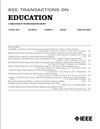跨校园程序设计课程教学实践与评估分析
IF 2
2区 工程技术
Q2 EDUCATION, SCIENTIFIC DISCIPLINES
引用次数: 0
摘要
在计算机科学教育的第一年有效地向学生教授编程是一项挑战。当学生群体由新手(即那些以前从未编程过的人)和专家程序员组成时,保持这两个群体的兴趣是特别麻烦的。因此,个性化教学不能在传统的讲堂中实现,因为学生人数较多,这对教学提出了挑战。本文根据多年的编程课程教学经验,提出了各种教学方法,并探讨了不同的评估形式,以促进学生的主动学习。我们进行了详细的分析,以了解不同的教学方法和不同的评估形式对学生的学习和对课程的感知的影响。这项分析是基于在三个不同校区开设的一门课程,课程描述相同。然而,两个校区之间的关键区别在于教学方法的选择,其中一个校区采用自下而上的教学法。相比之下,另外两个校区使用自上而下的教学法向学生教授编程概念。在这三个校区,课程的评估形式各不相同,既有常规的学校实践考试,也有理论选择题形式,有大流行期间的家庭实践考试,以及最近的作品集考试。根据对各校区成绩的分析和广泛的学生调查,研究结果显示,在学习成果上没有显著差异。本文章由计算机程序翻译,如有差异,请以英文原文为准。
Analyzing Pedagogic Practice and Assessments in a Cross-Campus Programming Course
Teaching programming efficiently to students in the first year of computer science education is challenging. It is especially cumbersome to retain the interest of both groups, when the student group consists of novice (i.e., those who have never programmed before) and expert programmers in the same crowd. Thus, individualized teaching cannot be achieved in a traditional lecture hall for a larger student population setting and poses a pedagogical challenge. This article presents various pedagogical approaches and explores different assessment forms to foster student active learning (SAL), drawing from years of experience teaching a programming course. A detailed analysis has been conducted to understand the effect on the students’ learning and perception of a course given different pedagogical approaches and varied assessment forms. The analysis is based on a course offered across three different campuses with the same course description. The key difference between the campuses however is the choice of pedagogical approach, where one of the campuses uses a bottom-up pedagogy. In contrast, the other two campuses use the top-down pedagogy to teach programming concepts to the students. Across the three campuses, the assessment form in the course has varied from regular practical school exams together with a theoretical multiple choice format, a practical home exam during the pandemic and most recently a portfolio. The findings show no significant differences in the learning outcomes based on an analysis of the grades across campuses and extensive student surveys.
求助全文
通过发布文献求助,成功后即可免费获取论文全文。
去求助
来源期刊

IEEE Transactions on Education
工程技术-工程:电子与电气
CiteScore
5.80
自引率
7.70%
发文量
90
审稿时长
1 months
期刊介绍:
The IEEE Transactions on Education (ToE) publishes significant and original scholarly contributions to education in electrical and electronics engineering, computer engineering, computer science, and other fields within the scope of interest of IEEE. Contributions must address discovery, integration, and/or application of knowledge in education in these fields. Articles must support contributions and assertions with compelling evidence and provide explicit, transparent descriptions of the processes through which the evidence is collected, analyzed, and interpreted. While characteristics of compelling evidence cannot be described to address every conceivable situation, generally assessment of the work being reported must go beyond student self-report and attitudinal data.
 求助内容:
求助内容: 应助结果提醒方式:
应助结果提醒方式:


